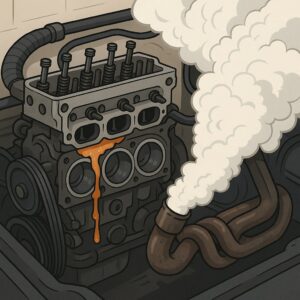Motorcycle accidents can turn an ordinary day into a nightmare in seconds. The injuries are often severe, and insurance claims can become overwhelming. That is why contacting a Buffalo motorcycle accident lawyer as soon as possible is so important. They can guide you through the process and make sure your rights are protected. With the right support, you can focus on recovery rather than fighting paperwork and insurers.
What is a Head Gasket
The head gasket is a vital part of your engine, sitting between the engine block and the cylinder head. It acts like a seal, keeping oil, coolant, and combustion gases in their proper places. Without it working properly, your engine can overheat or leak, causing serious problems.
How a Head Gasket Blows
When a head gasket fails, it usually does not happen out of the blue. Several factors can cause it to blow, and understanding them can help you spot problems early.
Overheating
Engines that run too hot put extreme pressure on the head gasket. Overheating can warp engine components and eventually cause the gasket to fail, leading to leaks and smoke.
Age and Wear
Like any part, head gaskets can wear out over time. Constant heat cycles and engine stress weaken the gasket material, eventually causing it to fail to seal properly.
Engine Stress
Hard driving, aggressive acceleration, or heavy towing can put extra stress on your engine. This pressure can cause small cracks or gaps in the head gasket, which can grow into serious leaks.
Poor Maintenance
Failing to change coolant or maintain oil regularly can increase the risk of a gasket blowing. Dirty or low fluid levels reduce cooling efficiency and can accelerate gasket wear.
Manufacturing Defects
Sometimes a head gasket fails simply because of a material or design defect. Even new engines are not immune if the gasket was faulty from the start.
Why a Blown Head Gasket Leads to Overheating
When a head gasket blows, it disrupts your engine’s heat management, often leading to overheating. Understanding how this happens can help you recognize the signs early.
Coolant Leaks
A blown head gasket can allow coolant to escape from the engine. Without enough coolant circulating, the engine cannot maintain a safe temperature and starts to overheat.
Coolant Contamination
Sometimes the gasket allows oil and coolant to mix, reducing the coolant’s ability to absorb heat. This contamination prevents proper cooling and can quickly raise engine temperature.
Loss of Pressure
The head gasket helps maintain the pressure needed for the cooling system to work efficiently. When the gasket fails, pressure drops, and coolant cannot flow properly, leading to overheating.
Hot Spots in the Engine
A damaged gasket can create uneven sealing in the engine cylinders. These hot spots make certain areas of the engine hotter than others, which can worsen overheating and cause additional engine damage.
Why White Smoke Appears from the Exhaust
White smoke coming from your exhaust is a clear warning that something is wrong with your engine. In most cases, it points directly to a problem with the head gasket.
Coolant Entering the Combustion Chamber
A blown head gasket can allow coolant to leak into the engine’s combustion chamber. When coolant burns along with the fuel, it produces thick white smoke from the exhaust.
Sweet Smell from the Smoke
White smoke caused by burning coolant often has a slightly sweet smell. This scent is a helpful clue that your engine is not just producing normal exhaust but is leaking fluids internally.
Continuous Smoke While Driving
Unlike occasional vapor, white smoke from a head gasket problem usually persists while the engine is running. It can get worse under load or after it has warmed up.
Potential Engine Damage
If the white smoke is ignored, the leaking coolant can overheat the engine or cause internal damage. Catching the problem early can prevent costly repairs and more serious failures.
Other Signs of a Blown Head Gasket
A blown head gasket often shows multiple warning signs beyond overheating and white smoke. Recognizing these early can save your engine from serious damage.
Loss of Engine Power
A failing head gasket can reduce the engine’s compression, which makes it harder for your motorcycle to accelerate. You might notice sluggish performance or trouble climbing hills that used to feel easy.
Rough Idling
The engine may run unevenly or shake at idle because combustion is not occurring properly in all cylinders. This roughness is a subtle but clear signal of internal engine issues.
Milky or Discolored Oil
When coolant mixes with oil, it can turn the oil milky and light brown. Checking your oil dipstick and noticing this change is a strong sign of a gasket problem.
Frequent Overheating
Even if you top off the coolant, the engine may continue to overheat. This repeated overheating is often caused by the gasket failing to maintain proper sealing and coolant flow.
Coolant Loss Without Visible Leaks
If your coolant level drops but you cannot see any leaks, it may be entering the engine through a blown gasket. This hidden loss can quietly damage the engine over time.
What to Do if You Suspect a Blown Head Gasket
If you think your head gasket might be blown, acting quickly can prevent serious engine damage. These steps will help you handle the problem safely and efficiently.
Stop Driving
Continuing to drive with a blown head gasket can make the damage much worse. Pull over safely and avoid running the engine until a professional can inspect it.
Check Fluids Carefully
Look for signs of coolant or oil mixing, or any unusual changes in fluid levels. This information can help a mechanic diagnose the problem more accurately.
Contact a Professional Mechanic
A certified mechanic can perform tests to confirm whether the head gasket is blown. Early diagnosis allows for timely repairs and can save your engine from further harm.
Avoid Temporary Fixes
Products that claim to seal a blown gasket temporarily may not work and can worsen the damage. It’s best to rely on proper repairs to resolve the issue entirely.
Document Symptoms and Observations
Keep notes on when overheating, white smoke, or strange noises occur. Providing detailed information to your mechanic can speed up diagnosis and ensure no issues are overlooked.
Conclusion
A blown head gasket can cause serious problems like overheating and white smoke, but catching the signs early can save your engine. Paying attention to warning signs and seeking professional help is always the best approach. Just as you would contact a Buffalo motorcycle accident lawyer after a crash, getting expert advice quickly can prevent small issues from turning into major damage.






